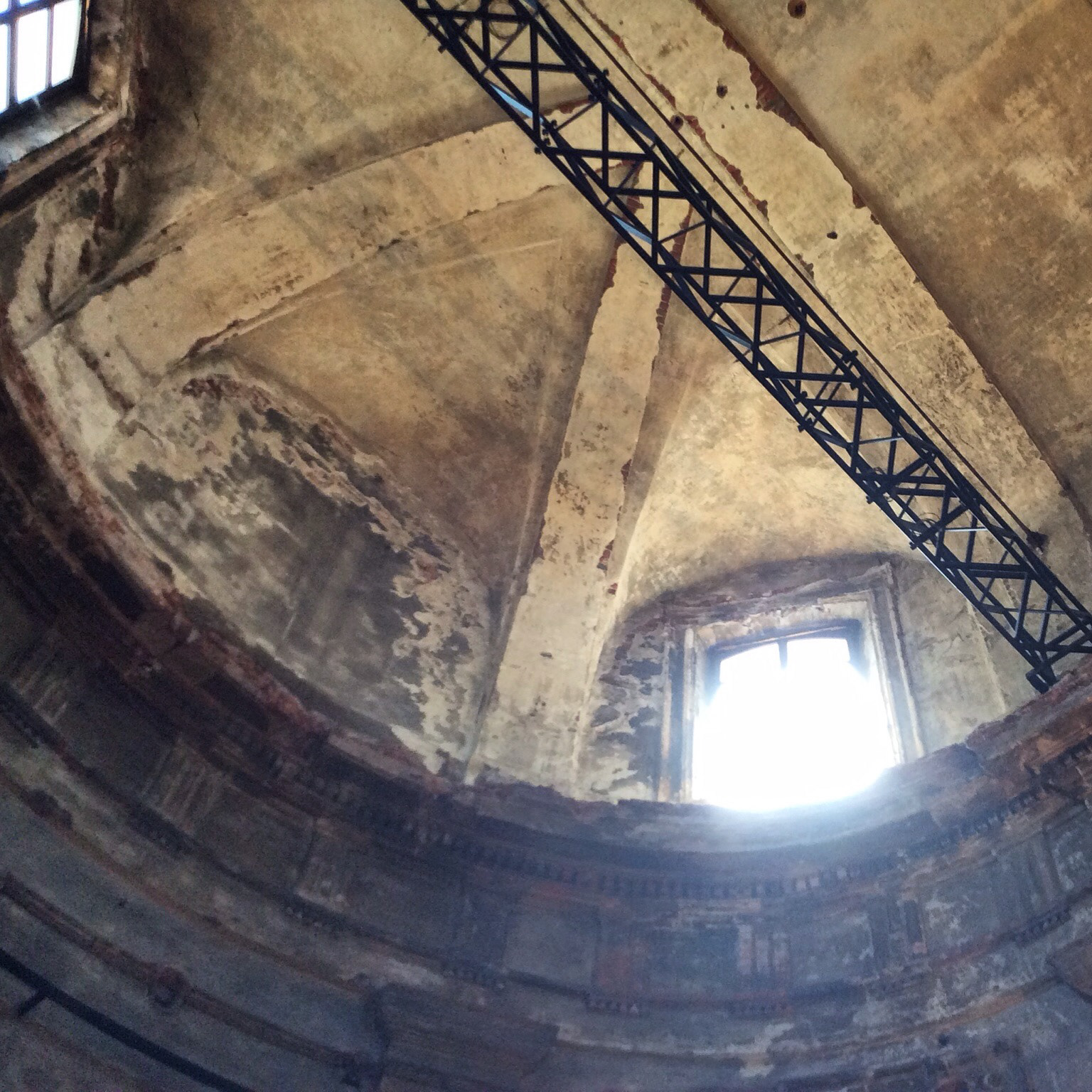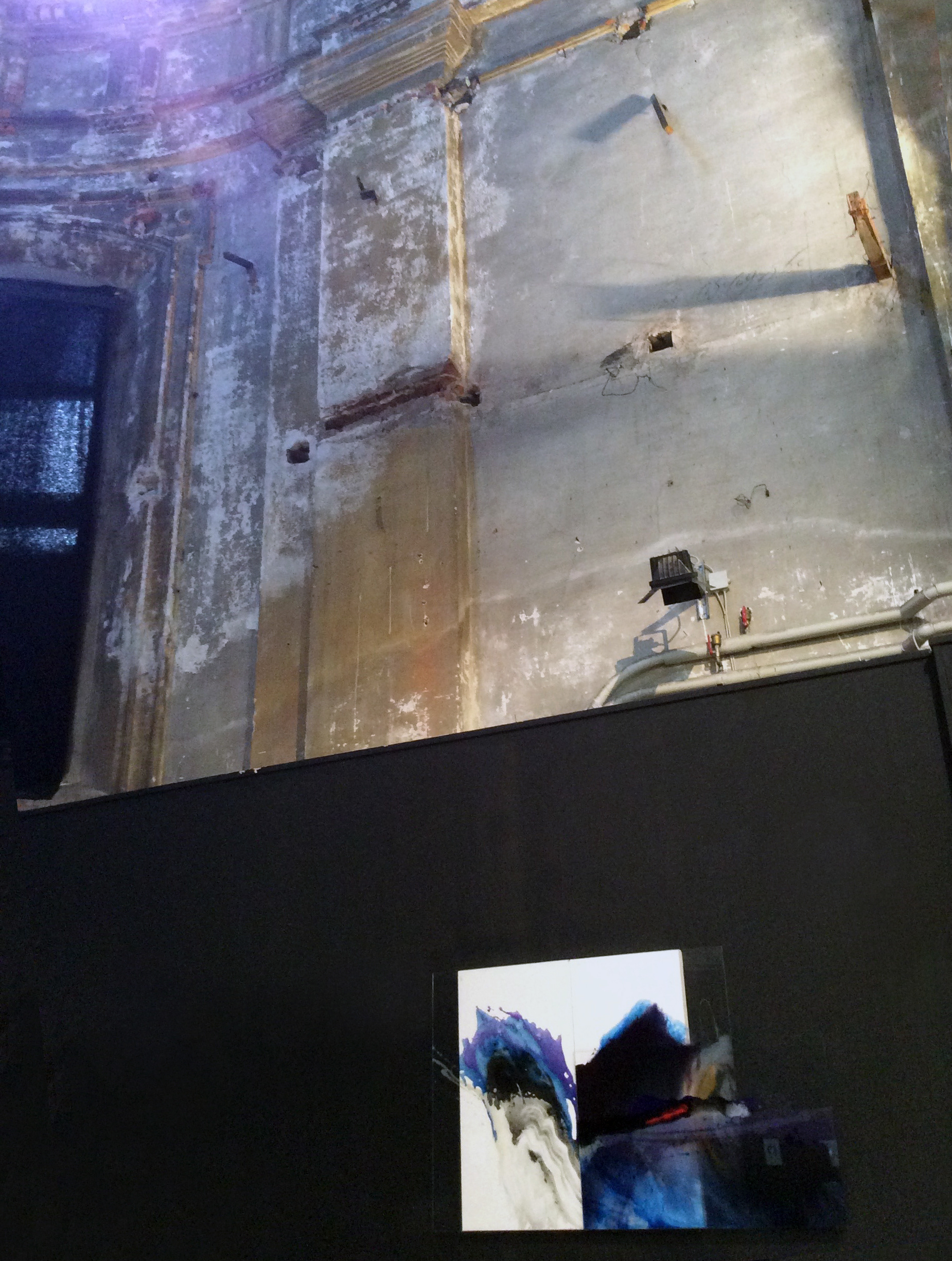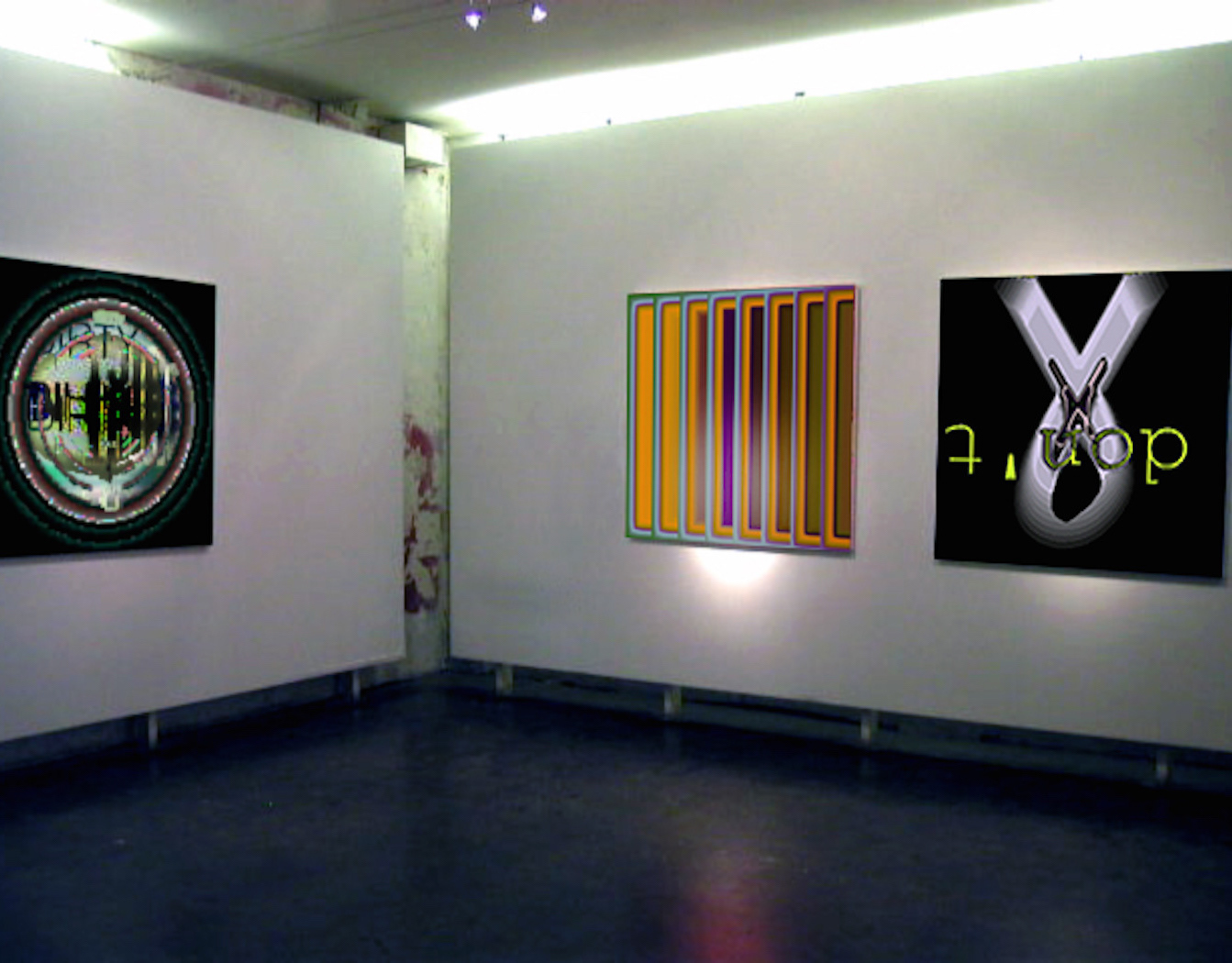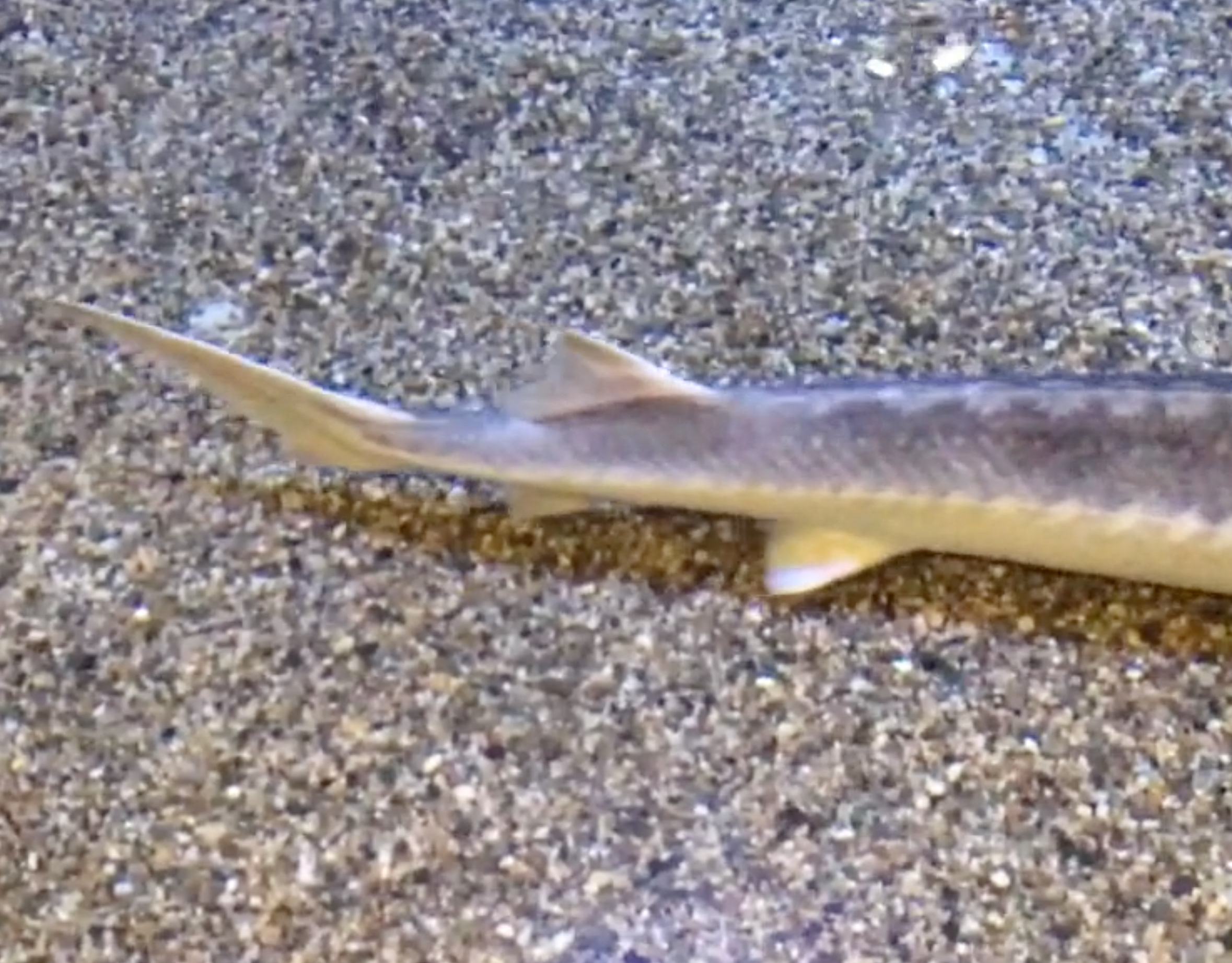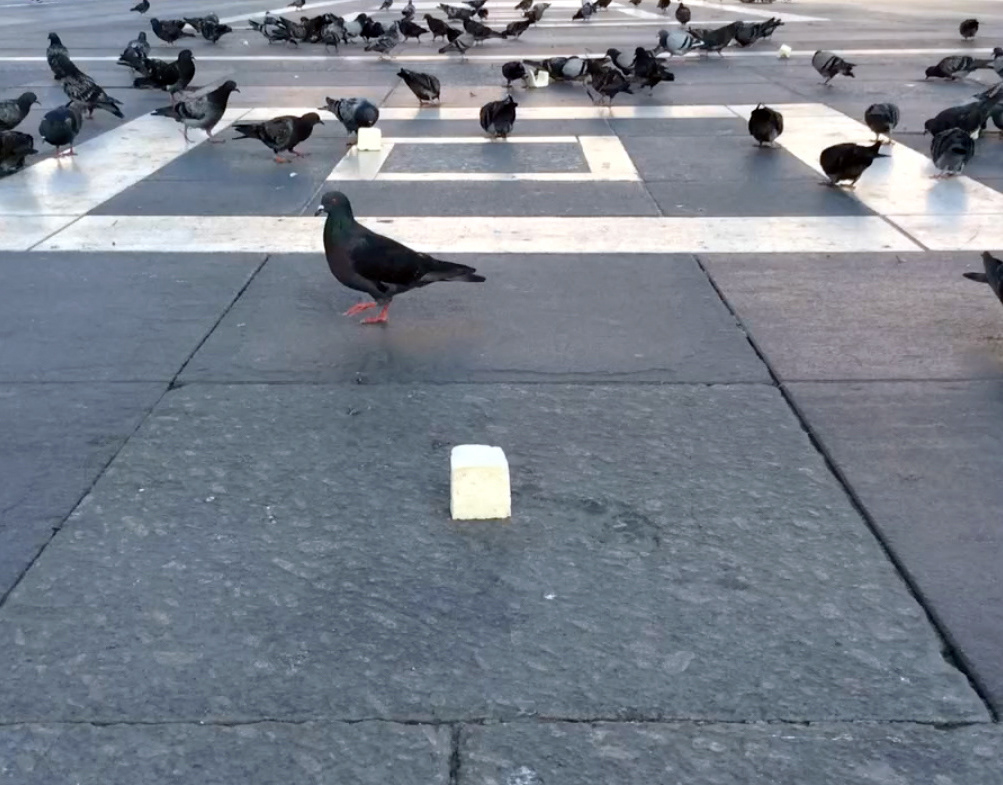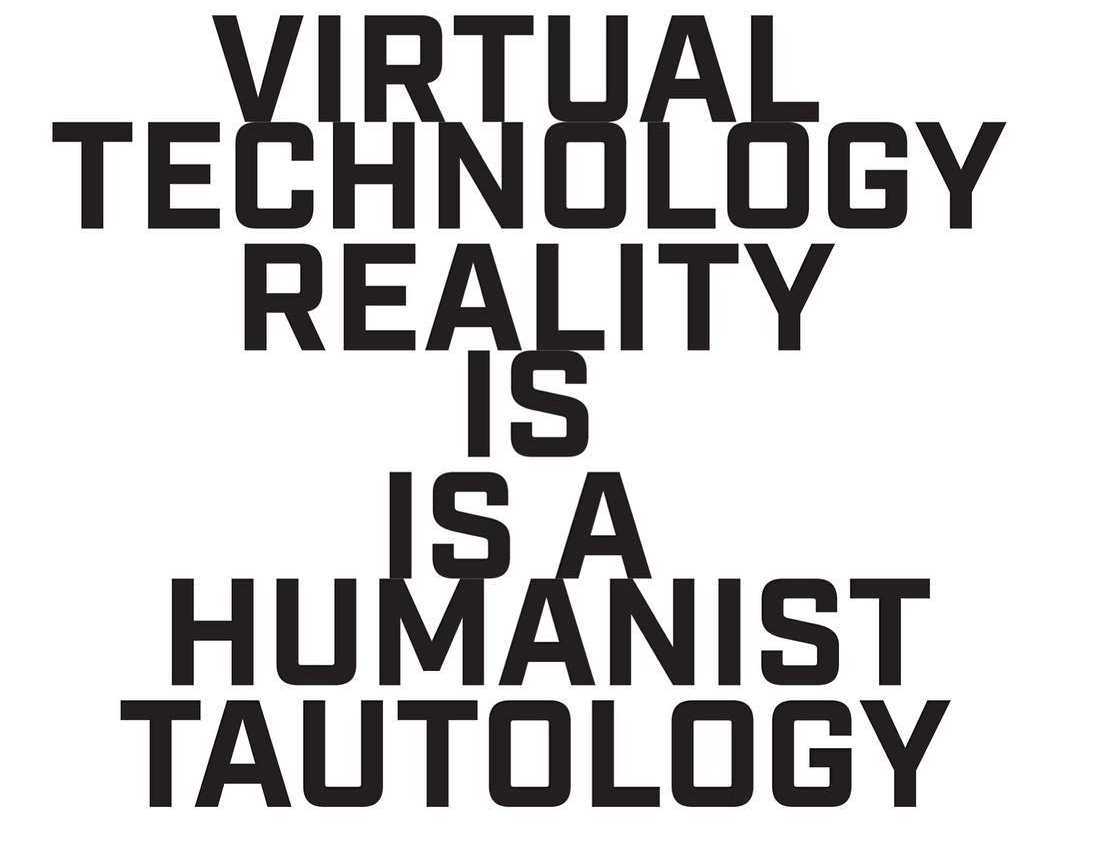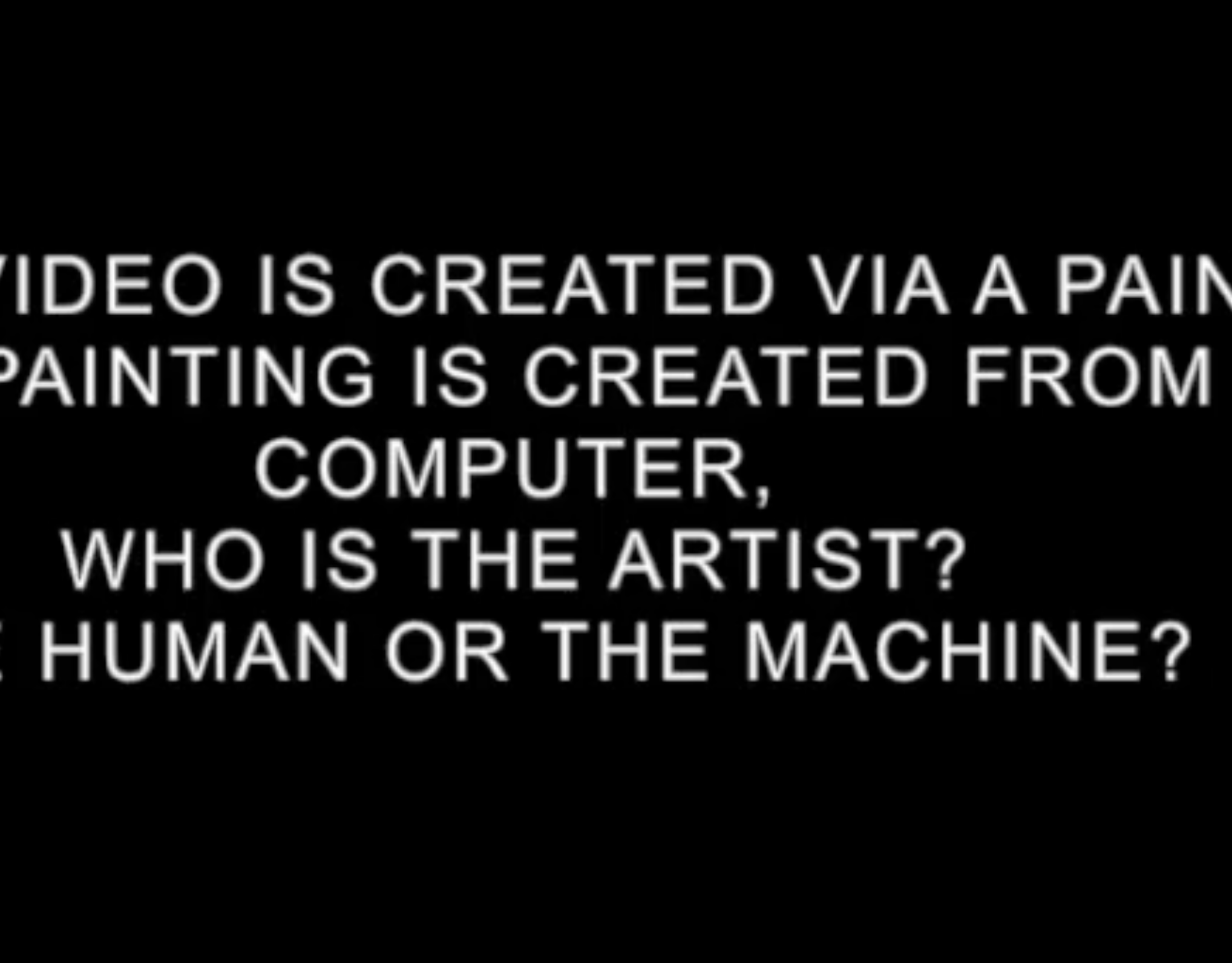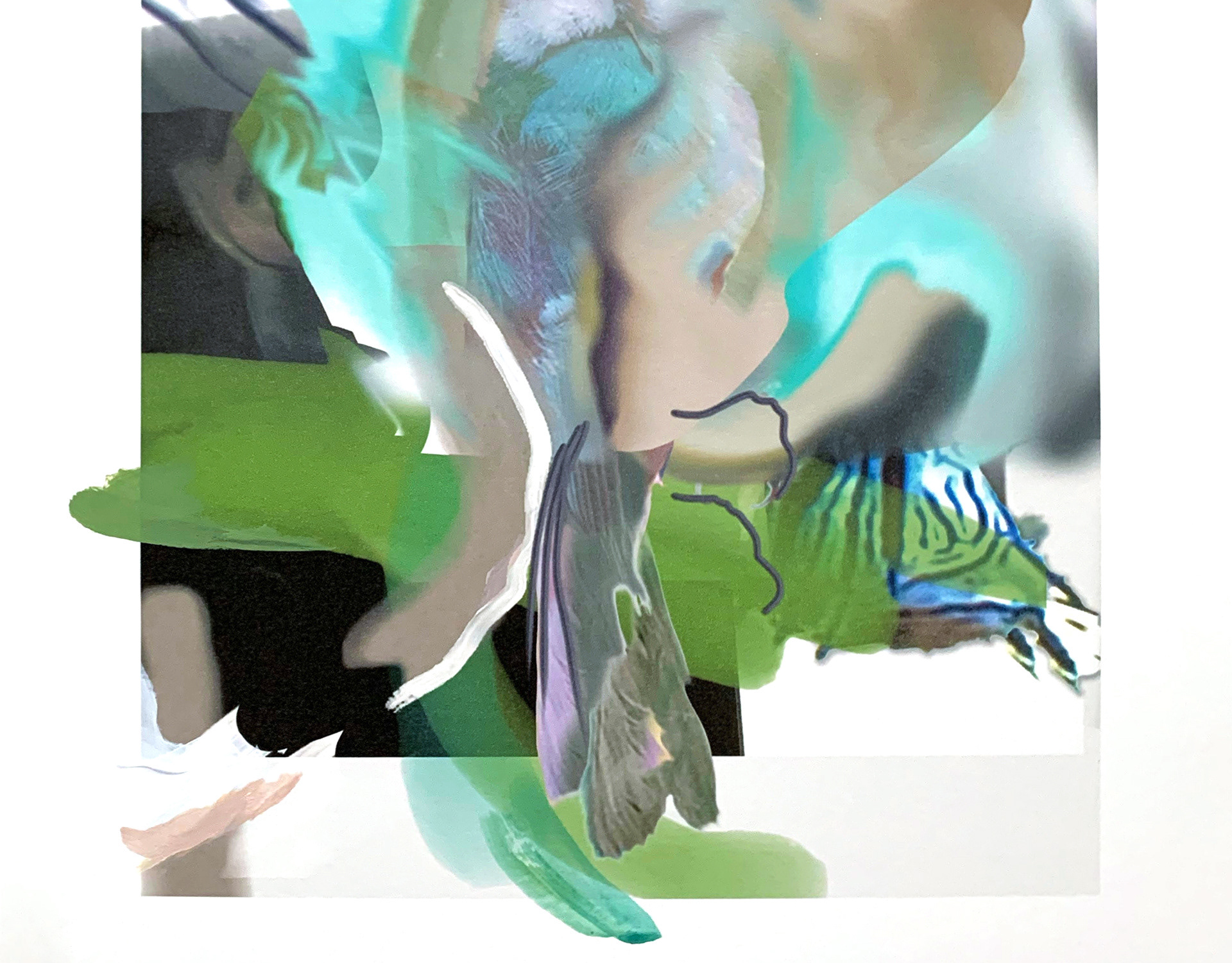No. 282729
From ART IS THE MACHINE series. Exhibited as part of group show COMBINA at the consecrated church San Carpoforo, Milan Italy
This work is the result of a philosophical investigation in which I explored painting on transparent substrate and the idea that one can rotate the work and see it as though in a mirror. This gave me an understanding of the idea of the dialectical consciousness and consequently an interest in the philosophy of becoming. My writings on this were published as a paper in the proceeding of International Association of Empirical Aesthetics.
Following on from this research I worked with the more than 40 works on plexiglass exploring the idea that an intuitive, subconscious practice opens the way for new concepts. Numbers were allocated to the works chronologically (in the order that each work came to be). These individual works created new works when placed together. For example No. 282729 was created from three panels of plexiglass (numbers 28, 27 and 29) superimposed over each other.

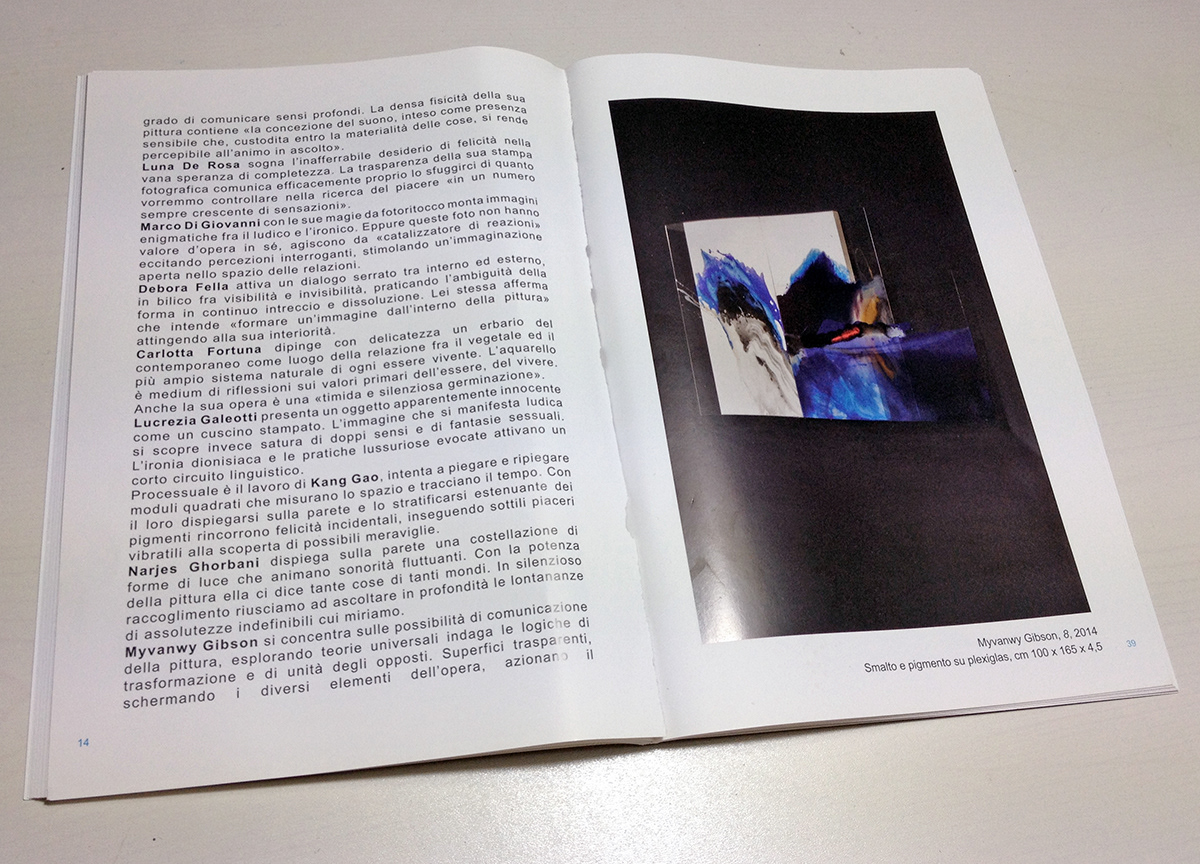
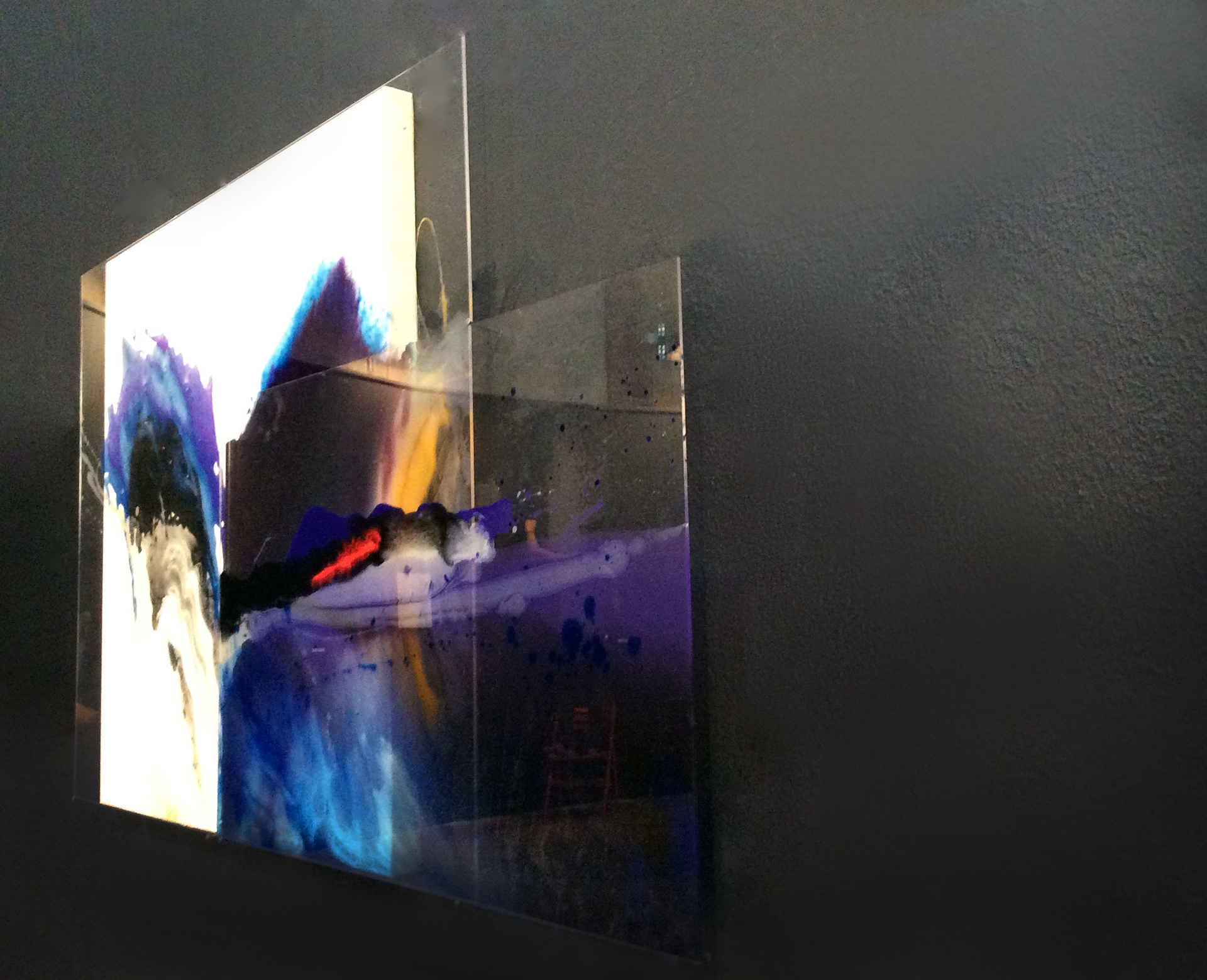
CRITICAL WRITING by Ana Laura Esposito, contemporary art critic and writer
On the Impossibility of Translation, or of Beauty as the Unspeakable (Translated)
I entered a deconsecrated church, a place that had become profane. Yet something brought me back to the dimension of mystery, but a mystery that proved distinct from religious devotion. I was in the former Church of San Carpoforo, Milan where the exhibition "Combina" was being held, featuring works by a group of students from Brera. I recalled the controversy sparked almost a century ago by Walter Benjamin's irrevocable verdict on the loss of a work of art's aura, and I mentally tried to reconstruct his most important postulates to counterpose, as if in an imaginary conversation, my arguments in favour of the existence of that unattainable distance. The aura had probably been transformed, but not definitively lost. I tried to save myself from this obsessive mental wandering so as not to get lost in the most diverse speculations. I returned to scrutinise the space, a building with more than ten centuries of history that had now become an exhibition space. A quick, furtive glance was all it took to trace the spatial coordinates, mentally sketch the next itinerary, and decide which work to begin with. '282729' immediately caught my eye.
My attention was captured by the transgression of the traditional boundaries of a work that could not be defined as a painting in the strict sense. The classic two-dimensionality of painting transcended traditional boundaries to be transformed through the incorporation of new elements. The opaqueness of the underlying canvas contrasted with the three acrylic glass panels, producing a strong and convincing physical effect. The systematic nature of the numbers, like a title, almost as if by definition opposed the overwhelming irruption of a powerful artistic gesture. A colour palette where white, black, and ultramarine blue were the undisputed protagonists.
Through the use of white canvases, transparent acrylic sheet, coloured pigments, enamel, and oil, Myvanwy Gibson managed to capture the viewer's gaze in a tension all her own, a tension that became the foundation of her expressive language. The irregularity and irreverence of the form/non-form rendered concrete through the splashes of colour contrasted with the perfect geometry of the surfaces. '282729' captured my attention, producing that contemplative silence exclusive to aesthetic experience. That silence, or that something more, which is inevitably followed by linguistic failure. A linguistic failure that explains the gap, the slippage between aesthetic experience and the critical text that seeks to translate something into words, which happens when we find ourselves before a work of art. This impossibility of translating into words the sensations produced by the aesthetic event had already been explained by Aristotle, intuiting that the unity of aesthetic experience can only be mutilated, broken in the linguistic act, never translated. Consequently, the entire critical act in the world of art is the fruit of a half-completed linguistic failure. In this way, art criticism manifests itself as an inexhaustible mise en abyme that carries with it, gap after gap, a continuous slippage that reproduces itself ad infinitum. An unlimited postponement: the nonsense of representation, to use Giulio Paolini's words.
This reflection over which you are now casting your gaze is a perfect example of the way that the physicality of the artwork has for Myvanwy. The gesture made material as the starting point of thought. As she herself points out, if for Sol Lewitt "The idea becomes a machine that makes the art," for her, "the art becomes the machine that makes the idea".
I entered a deconsecrated church, a place that had become profane. Yet something brought me back to the dimension of mystery, but a mystery that proved distinct from religious devotion. I was in the former Church of San Carpoforo, Milan where the exhibition "Combina" was being held, featuring works by a group of students from Brera. I recalled the controversy sparked almost a century ago by Walter Benjamin's irrevocable verdict on the loss of a work of art's aura, and I mentally tried to reconstruct his most important postulates to counterpose, as if in an imaginary conversation, my arguments in favour of the existence of that unattainable distance. The aura had probably been transformed, but not definitively lost. I tried to save myself from this obsessive mental wandering so as not to get lost in the most diverse speculations. I returned to scrutinise the space, a building with more than ten centuries of history that had now become an exhibition space. A quick, furtive glance was all it took to trace the spatial coordinates, mentally sketch the next itinerary, and decide which work to begin with. '282729' immediately caught my eye.
My attention was captured by the transgression of the traditional boundaries of a work that could not be defined as a painting in the strict sense. The classic two-dimensionality of painting transcended traditional boundaries to be transformed through the incorporation of new elements. The opaqueness of the underlying canvas contrasted with the three acrylic glass panels, producing a strong and convincing physical effect. The systematic nature of the numbers, like a title, almost as if by definition opposed the overwhelming irruption of a powerful artistic gesture. A colour palette where white, black, and ultramarine blue were the undisputed protagonists.
Through the use of white canvases, transparent acrylic sheet, coloured pigments, enamel, and oil, Myvanwy Gibson managed to capture the viewer's gaze in a tension all her own, a tension that became the foundation of her expressive language. The irregularity and irreverence of the form/non-form rendered concrete through the splashes of colour contrasted with the perfect geometry of the surfaces. '282729' captured my attention, producing that contemplative silence exclusive to aesthetic experience. That silence, or that something more, which is inevitably followed by linguistic failure. A linguistic failure that explains the gap, the slippage between aesthetic experience and the critical text that seeks to translate something into words, which happens when we find ourselves before a work of art. This impossibility of translating into words the sensations produced by the aesthetic event had already been explained by Aristotle, intuiting that the unity of aesthetic experience can only be mutilated, broken in the linguistic act, never translated. Consequently, the entire critical act in the world of art is the fruit of a half-completed linguistic failure. In this way, art criticism manifests itself as an inexhaustible mise en abyme that carries with it, gap after gap, a continuous slippage that reproduces itself ad infinitum. An unlimited postponement: the nonsense of representation, to use Giulio Paolini's words.
This reflection over which you are now casting your gaze is a perfect example of the way that the physicality of the artwork has for Myvanwy. The gesture made material as the starting point of thought. As she herself points out, if for Sol Lewitt "The idea becomes a machine that makes the art," for her, "the art becomes the machine that makes the idea".
"My practice (...) is a combinaton of the intuitive and the analytical. The aesthetic of the work has equal importance to the idea(s). The intuitive practice and the conceptualisation of the work evolve in a helical motion." There is no doubt about the centrality of content and matter, concept and expression, idea and gesture.
Born in Melbourne, Australia, in 1965, Myvanwy lives and works in Milan, where, as part of her intensive artistic research at the Brera Academy of Fine Arts, she discovered acrylic glass as the most suitable surface for her expressive language. Before moving to Italy, she experimented with other media, such as performance and video, but always focused on the performative need, the phenomenology of light, and the philosophy of mind: "The need to 'act,' to perform has always been part of my artistic expression, and the philosophy of mind and the topic of consciousness is the basis of the theoretical part of my practice."
Born in Melbourne, Australia, in 1965, Myvanwy lives and works in Milan, where, as part of her intensive artistic research at the Brera Academy of Fine Arts, she discovered acrylic glass as the most suitable surface for her expressive language. Before moving to Italy, she experimented with other media, such as performance and video, but always focused on the performative need, the phenomenology of light, and the philosophy of mind: "The need to 'act,' to perform has always been part of my artistic expression, and the philosophy of mind and the topic of consciousness is the basis of the theoretical part of my practice."
Like the leading exponents of action painting, Myvanwy allows for spontaneity and gesture, which, along with colour, unfold like an unpredictable work in progress. What sets her apart from abstract expressionism is that her work is not merely gesture, action, or unconscious expression; her artistic practice is grounded in the profound theoretical-analytical path she has developed herself. A multifaceted artist, she intertwines mind and body in a multi-layered sign practice. Here, theory and practice, analysis and intuition, are revealed in her works as pairs of opposites that are not mutually exclusive but coexist in the arena of artistic creation. Thesis, antithesis, synthesis.
Conceptual rigour combines with the freedom that artwork represents as a means of expression. Discipline and pleasurable chaos are another pair of opposites that intersect in her work. Rigour in the realm of conceptual thought, freedom and an unplanned artistic gesture that takes shape on the transparent surface. Concept and matter. Matter and concept. Dialogical terms that can only be broken down, as we mentioned earlier, in the logical sense of language as an objectifying practice of the artistic gesture.
Her works possess these multiple values. A system composed of intuition and premeditation, emotional expressiveness and intellectual calculation. An artistic practice that combines system with a-systematicity. The strength of Myvanwy's work lies in this combinatorial play of analysis, conceptual decomposition, and the spontaneity of the artistic gesture. A spiral movement that, like a tornado, powerfully spins in a circular form, overwhelming practice and thought in a single concrete fact: the work as the expression of a process.
Conceptual rigour combines with the freedom that artwork represents as a means of expression. Discipline and pleasurable chaos are another pair of opposites that intersect in her work. Rigour in the realm of conceptual thought, freedom and an unplanned artistic gesture that takes shape on the transparent surface. Concept and matter. Matter and concept. Dialogical terms that can only be broken down, as we mentioned earlier, in the logical sense of language as an objectifying practice of the artistic gesture.
Her works possess these multiple values. A system composed of intuition and premeditation, emotional expressiveness and intellectual calculation. An artistic practice that combines system with a-systematicity. The strength of Myvanwy's work lies in this combinatorial play of analysis, conceptual decomposition, and the spontaneity of the artistic gesture. A spiral movement that, like a tornado, powerfully spins in a circular form, overwhelming practice and thought in a single concrete fact: the work as the expression of a process.
ART IS THE MACHINE No. 282729 pigments, enamel, canvas, acrylic glass panels x 3. 1650mm x 1000mm
